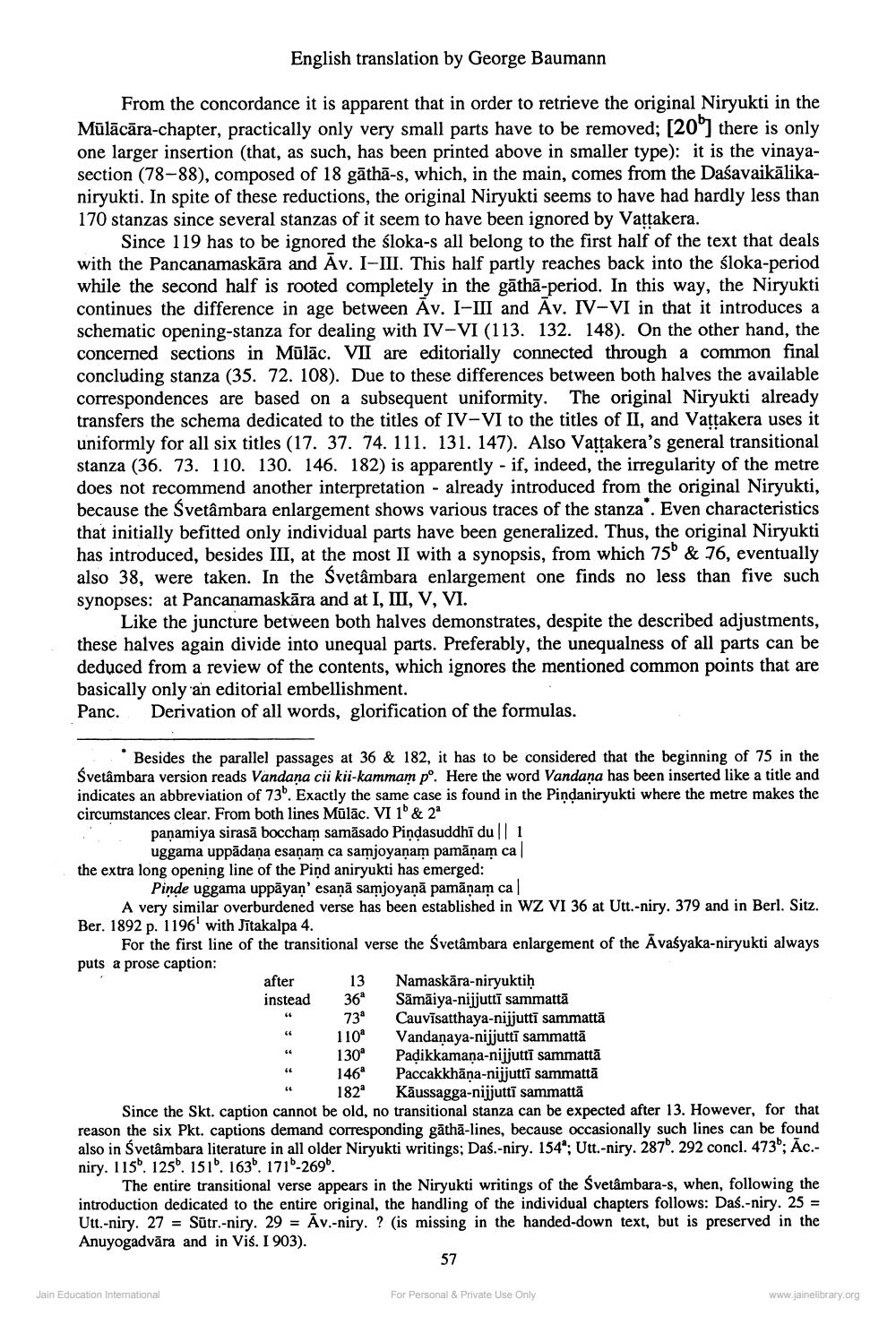________________
English translation by George Baumann
From the concordance it is apparent that in order to retrieve the original Niryukti in the Mūlācāra-chapter, practically only very small parts have to be removed; [20°) there is only one larger insertion (that, as such, has been printed above in smaller type): it is the vinayasection (78-88), composed of 18 gāthā-s, which, in the main, comes from the Daśavaikālikaniryukti. In spite of these reductions, the original Niryukti seems to have had hardly less than 170 stanzas since several stanzas of it seem to have been ignored by Vattakera.
Since 119 has to be ignored the sloka-s all belong to the first half of the text that deals with the Pancanamaskāra and Av. I-III. This half partly reaches back into the sloka-period while the second half is rooted completely in the gāthā-period. In this way, the Niryukti continues the difference in age between Āv. I-III and Āv. IV-VI in that it introduces a schematic opening-stanza for dealing with IV-VI (113. 132. 148). On the other hand, the concerned sections in Mūlāc. VII are editorially connected through a common final concluding stanza (35. 72. 108). Due to these differences between both halves the available correspondences are based on a subsequent uniformity. The original Niryukti already transfers the schema dedicated to the titles of IV-VI to the titles of II, and Vattakera uses it uniformly for all six titles (17. 37. 74. 111. 131. 147). Also Vattakera's general transitional stanza (36. 73. 110. 130. 146. 182) is apparently - if, indeed, the irregularity of the metre does not recommend another interpretation - already introduced from the original Niryukti, because the Svetâmbara enlargement shows various traces of the stanza. Even characteristics that initially befitted only individual parts have been generalized. Thus, the original Niryukti has introduced, besides III, at the most II with a synopsis, from which 756 & 76, eventually also 38, were taken. In the Svetâmbara enlargement one finds no less than five such synopses: at Pancanamaskāra and at I, III, V, VI.
Like the juncture between both halves demonstrates, despite the described adjustments, these halves again divide into unequal parts. Preferably, the unequalness of all parts can be deduced from a review of the contents, which ignores the mentioned common points that are basically only an editorial embellishment. Panc. Derivation of all words, glorification of the formulas.
Besides the parallel passages at 36 & 182, it has to be considered that the beginning of 75 in the Svetâmbara version reads Vandana cii kii-kammam po. Here the word Vandana has been inserted like a title and indicates an abbreviation of 736. Exactly the same case is found in the Pindaniryukti where the metre makes the circumstances clear. From both lines Mülāc. VI 10 & 2
paņamiya sirasā boccham samāsado Pindasuddhi du || !
uggama uppādana esanam ca samjoyanam pamānam ca the extra long opening line of the Pind aniryukti has emerged:
Pinde uggama uppāyan esaņā samjoyaņā pamāṇam ca
A very similar overburdened verse has been established in WZ VI 36 at Utt.-niry. 379 and in Berl. Sitz. Ber. 1892 p. 1196' with Jītakalpa 4.
For the first line of the transitional verse the Svetâmbara enlargement of the Āvaśyaka-niryukti always puts a prose caption:
after 13 Namaskāra-niryuktih instead
Sāmāiya-nijjuttī sammattā Cauvisatthaya-nijjutti sammattā
Vandanaya-nijjuttī sammattā 130 Padikkamana-nijjuttī sammattā 146 Paccakkhāna-nijjuttī sammattā
182 Kāussagga-nijjuttī sammattā Since the Skt. caption cannot be old, no transitional stanza can be expected after 13. However, for that reason the six Pkt. captions demand corresponding gāthā-lines, because occasionally such lines can be found also in Svetâmbara literature in all older Niryukti writings: Das.-niry. 154"; Utt.-niry. 287.292 concl. 473'; Ac.niry. 1156.1256.1516. 1636. 1710-2696.
The entire transitional verse appears in the Niryukti writings of the Svetâmbara-s, when, following the introduction dedicated to the entire original, the handling of the individual chapters follows: Das.-niry. 25 = Utt.-niry. 27 = Sūtr.-niry. 29 = Av.-niry. ? (is missing in the handed-down text, but is preserved in the Anuyogadvāra and in Vis. I 903).
57
36
730
1100
Jain Education International
For Personal & Private Use Only
www.jainelibrary.org




